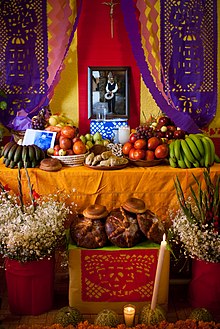
The Day of the Dead is a holiday traditionally celebrated on November 1 and 2, though other days, such as October 31 or November 6, may be included depending on the locality. The multi-day holiday involves family and friends gathering to pay respects and remember friends and family members who have died. These celebrations can take a humorous tone, as celebrants remember amusing events and anecdotes about the departed. It is widely observed in Mexico, where it largely developed, and is also observed in other places, especially by people of Mexican heritage. The observance falls during the Christian period of Allhallowtide. Some argue that there are Indigenous Mexican or ancient Aztec influences that account for the custom, though others see it as a local expression of the Allhallowtide season that was brought to the region by the Spanish; the Day of the Dead has become a way to remember those forebears of Mexican culture. The Day of the Dead is largely seen as having a festive characteristic.

Papantla is a city and municipality located in the north of the Mexican state of Veracruz, in the Sierra Papanteca range and on the Gulf of Mexico. The city was founded in the 13th century by the Totonacs and has dominated the Totonacapan region of the state since then. The region is famed for vanilla, which occurs naturally in this region, the Danza de los Voladores and the El Tajín archeological site, which was named a World Heritage Site. Papantla still has strong communities of Totonacs who maintain the culture and language. The city contains a number of large scale murals and sculptures done by native artist Teodoro Cano García, which honor the Totonac culture. The name Papantla is from Nahuatl and most often interpreted to mean "place of the papanes". This meaning is reflected in the municipality's coat of arms.

Papel picado is a traditional Mexican decorative craft made by cutting elaborate designs into sheets of tissue paper. Papel picado is considered a Mexican folk art. The designs are commonly cut from as many as 40-50 colored tissue papers stacked together and using a guide or template, a small mallet, and chisels, creating as many as fifty banners at a time. Papel picado can also be made by folding tissue paper and using small, sharp scissors. Common themes include birds, floral designs, and skeletons. Papel picados are commonly displayed for both secular and religious occasions, such as Easter, Christmas, the Day of the Dead, as well as during weddings, quinceañeras, baptisms, and christenings. In Mexico, papel picados are often incorporated into the altars (ofrendas) during the Day of the Dead and are hung throughout the streets during holidays. In the streets of Mexico, papel picados are often strung together to create a banner that can either be hung across alleyways or displayed in the home.

La Calavera Catrina had its origin as a zinc etching created by the Mexican printmaker and lithographer José Guadalupe Posada (1852–1913). The image is usually dated c. 1910–12. Its first certain publication date is 1913, when it appeared in a satiric broadside as a photo-relief etching.
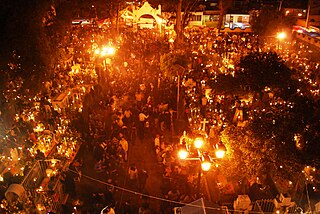
San Andres Míxquic is a community located in the southeast of the Distrito Federal in the borough of Tláhuac. The community was founded by the 11th century on what was a small island in Lake Chalco. “Míxquic” means “in mesquite” but the community's culture for most of its history was based on chinampas, gardens floating on the lake's waters and tied to the island. Drainage of Lake Chalco in the 19th and 20th century eventually destroyed the chinampas but the community is still agricultural in nature, despite being officially in the territory of Mexico City.

Tagetes erecta, the Aztec marigold, Mexican marigold, big marigold, cempaxochitl or cempasúchil, is a species of flowering plant in the genus Tagetes native to Mexico and Guatemala. Despite being native to the Americas, it is often called the African marigold. In Mexico, this plant is found in the wild in the states of México, Michoacán, Puebla, Veracruz and Guerrero.

El Muerto is a 2007 American independent superhero film based on the comic book series, El Muerto: The Aztec Zombie created by Javier Hernandez. The film was written and directed by Brian Cox with Javier Hernandez serving as Associate-Producer. It stars Wilmer Valderrama, Angie Cepeda, Joel David Moore, Billy Drago, Tony Plana, Michael Parks, María Conchita Alonso and Tony Amendola. The film follows the story of Diego de la Muerte, a 21-year-old Mexican-American who is abducted, sacrificed, and sent back to the land of the living by the Aztec gods of death and destiny to fulfill an ancient prophecy. The official premiere was held on March 1, 2007 at the Latino Film Festival in San Diego, California with a straight-to-DVD release slated for September 18, 2007 followed by subsequent screenings in New York City and San Diego. The official site address (www.elmuertomovie.com) has since been re-directed to a MySpace film account. The film is rated PG-13 for violence and some disturbing images. El Muerto has gone on to win the Best Feature Film Award at the first annual Whittier Film Festival in 2008.

A calavera, in the context of the Day of the Dead, is a representation of a human skull or skeleton. The term is often applied to edible or decorative skulls made from either sugar or clay, used in the Mexican celebration of the Day of the Dead and the Roman Catholic holiday All Souls' Day. Calavera can also refer to any artistic representations of skulls or skeletons, such as those in the prints of José Guadalupe Posada, or to gifts or treats in relation to the Day of the Dead. Some widely known calaveras are created with cane sugar, decorated with items such as colored foil, icing, beads, and sometimes objects such as feathers. They range in multiple colors.

Self Help Graphics & Art, Inc. is a community arts center in East Los Angeles, California, United States. Established in 1970, Self Help Graphics served as a critical locus of activity during the Chicano art movement and is a center for Chicano and Latino artistic production. SHG is most well-known for organizing annual Day of the Dead festivities, in addition to hosting exhibitions and musical performances. Throughout its history, the organization has worked with well-known artists in the Los Angeles area such as Barbara Carrasco, Los Four, the East Los Streetscapers, and Shizu Saldamando.

Pan de muerto is a type of pan dulce traditionally baked in Mexico and the Mexican diaspora during the weeks leading up to the Día de Muertos, which is celebrated from November 1 to November 2.

Ocotepec is a small town to the north of the city of Cuernavaca, but within the municipality of Cuernavaca, Mexico. The name Ocotepec means “on the hill of the ocotes, or Montezuma pines.” It is located only minutes from the center of Cuernavaca on the highway that leads to Tepoztlán. The community is divided into four neighborhoods based on the major churches in town, which is an organization left over from the colonial period. The four neighborhoods are Candelaria, Dolores, Ramos, and Santa Cruz, each with its own patron saint and feast day. This organization is part of the reason why this community has managed to maintain more ancient traditions, a number of which date from the pre-Hispanic period. Ocotepec is one of the most traditional communities in the municipality of Cuernavaca. On the main road through town, there are dozens of stores specializing in handcrafted clay, stone and wood pieces, as well as rustic furniture. Among these shops are restaurants and food stalls specializing in barbacoa and cecina.

The Alfeñique fair is an annual event that takes place in the city of Toluca, Mexico in which vendors sell traditional sugar skulls with names labeled on the forehead, as well as candy in a variety of shapes, in order to celebrate the Mexican holiday Día de Muertos. Chocolate and sugar skulls are used to decorate altars dedicated to the dead during the celebration.
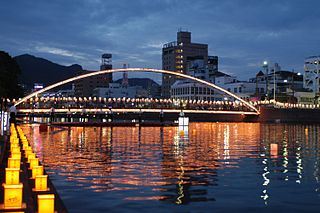
Festival of the Dead or Feast of Ancestors is held by many cultures throughout the world in honor or recognition of deceased members of the community, generally occurring after the harvest in August, September, October, or November.
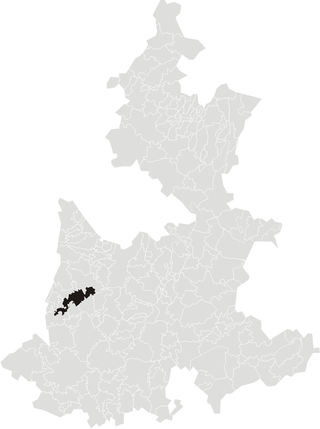
Huaquechula is a town in Huaquechula Municipality located in state of Puebla in central Mexico. The settlement dates back at least as far as 1110 CE although its center has moved to twice to its current location. Since its founding, it has been an agricultural community, today raising crops such as peanuts, corn and sorghum, although there are some handcrafts as well. The town is known for its traditions related to the Feast of the Cross, but even more so for its “cabo del año” altars on Day of the Dead, which are dedicated to family members who have died during the previous year. These have been declared a cultural heritage of the state of Puebla and bring tourists to the town, mostly from Puebla.
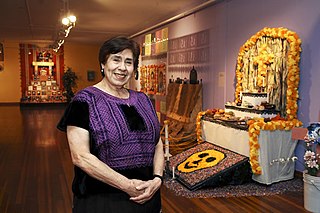
Herminia Albarrán Romero is a Mexican-American artist known for her papel picado and altar-making. She received a National Heritage Fellowship from the National Endowment for the Arts in 2005, which is the United States' highest honor in the folk and traditional arts.

San Salvador Huixcolotla is a town and municipality in the Mexican state of Puebla in southeastern Mexico that may be best known as the birthplace of papel picado. San Salvador is of Spanish origin and translates to "Holy Savior" and Huixcolotla is Nahuatl for "place of the curved spines".

There are extensive and varied beliefs in ghosts in Mexican culture. In Mexico, the beliefs of the Maya, Nahua, Purépecha; and other indigenous groups in a supernatural world has survived and evolved, combined with the Catholic beliefs of the Spanish. The Day of the Dead incorporates pre-Columbian beliefs with Christian elements. Mexican literature and cinema include many stories of ghosts interacting with the living.

Rodolfo Villena Hernández is a Mexican artisan who specializes in “cartonería” a type of hard paper mache used to sculpt piñatas, holiday decorations, Judas figures as well as the building of monumental works which have been exhibited in Puebla, Mexico City and Chicago. He has also been involved in theater. His work has been recognized with various awards over his career.

Marquesote is a traditional bread that forms part of the Mexican cuisine. It is popular in some specific states in Mexico, including Oaxaca, Chiapas, Veracruz, and Puebla. Within the towns of these states, the bread is often sold in local markets.
Ofelia Esparza is a Chicana altar installation artist, and educator in East Los Angeles, California.
